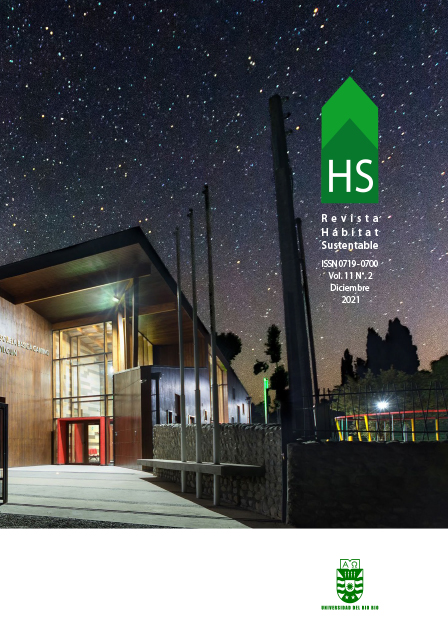Architecture research trends between 2016-2020 in the SCOPUS database, and their relationship with the creation of research groups
DOI:
https://doi.org/10.22320/07190700.2021.11.02.04Keywords:
sustainability, bioclimatic architecture, bibliometrics, research trendsAbstract
The interest in making research more dynamic within universities has evidenced the need for the creation of research groups. In this sense, the purpose of this article is to establish a relationship between the data obtained from bibliometrics and the profile and interest of Architecture Faculty researchers, to identify research niches that guide their work. This research was carried out through a systematic review and use of scientific production bibliometric tools in the last five years within the architecture domain in the SCOPUS database. The research made used five steps that guided the process: search; evaluation; synthesis; analysis; and monitoring. Through the search process, 1,465 scientific documents were obtained, analyzed with the Bibliometrix web application using indicators that allowed obtaining the results, to connect them to both teaching interests and profiles. The analysis identified that sustainability, design, and energy efficiency are topics of interest and constitute trending topics to promote the work and the constitution of research groups.
Downloads
References
AGNETE, V., AINA, A., SVEIN, K. E INGVILD, R. (2016). The establishment of formal research groups inhigher education institutions. Nordic Journal of Studiesin Educational Policy, 2016(2-3). DOI: 10.3402/nstep.v2.33896
AGUADED, I. (2020). Publicado el nuevo SCOPUS-2019: ‘Comunicar’, indiscutible líder entre las revistas hispanas. Comunicar. Revista Científica de Educación y Comunicación. DOI: https://doi.org/10.3916/escuela-de-autores-136
ARIA, M. Y CUCCURULLO, C. (2017). bibliometrix: An R-tool for comprehensive science mapping analysis. Journal of Informetrics, 11(4), 959–975. DOI: https://doi.org/10.1016/j.joi.2017.08.007
BERMEO-GIRALDO, M. C., ACEVEDO CORREA, Y., PALACIOS MOYA, L., BENJUMEA ARIAS, M. Y ARANGO-BOTERO, D. (2020). Evolución y tendencias investigativas sobre estrategias de gestión de conocimiento en instituciones de educación superior. Revista Virtual Universidad Católica del Norte, 5821(60), 202–227. DOI: https://doi.org/10.35575/rvucn.n60a11
BLAKEMAN, K. (2018). Bibliometrics in a digital age: help or hindrance. Science progress, 101(3), 293-310. DOI: https://doi.org/10.3184/003685018X15337564592469
CHUQUIN J. Y SALAZAR W. (2019). Manual para la aplicación de indicadores de produccion científica en Ecuador asociado a Scopus. Recuperado de https://bookdown.org/mabecita3/_book2/#elaborado-por
Ciencia Unisallle (2020). Guía de visualización de datos: Bibliometrix. Recuperado de https://ciencia.lasalle.edu.co/recursos_bibliograficos/30
D’AMANZO, M., MERCADO, M. V. Y GANEM-KARLEN, C. (2020). 10 preguntas de los edificios energía cero: revisión del estado del arte. Hábitat Sustentable, 10(2), 24 - 41. DOI: https://doi.org/10.22320/07190700.2020.10.02.02
DUQUE, P. Y CERVANTES, L.S. (2019). Responsabilidad Social Universitaria: una revisión sistemática y análisis bibliométrico. Estudios Gerenciales, 35(153), 451-464. DOI: https://doi.org/10.18046/j.estger.2019.153.3389
GALLARDO, E. (2016). Seminario: “Bibliometría y Revisiones sistemáticas: Una aproximación al análisis de la literatura científica en el área de Empresa. DOI: https://doi.org/10.13140/RG.2.1.3461.7204
GRANT, M. J. Y BOOTH, A. (2009). A typology of reviews: An analysis of 14 review types and associated methodologies. Health Information and Libraries Journal, 26(2), 91–108. DOI: https://doi.org/10.1111/j.1471-1842.2009.00848.x
GONZÁLEZ C., A. Y TREBILCOCK K., M. (2012). La sostenibilidad en el currículo de las carreras de arquitectura: Implicaciones del concepto de sostenibilidad en el perfil profesional y el plan de estudios de las carreras de arquitectura en América Latina. Hábitat Sustentable, 2(1), 26-35. Recuperado de http://revistas.ubiobio.cl/index.php/RHS/article/view/410
MANTEROLA, C., ASTUDILLO, P., ARIAS, E. Y CLAROS, N. (2013). Revisiones sistemáticas de la literatura. Qué se debe saber acerca de ellas. Cirugía Española, 91(3), 149–155. DOI: https://doi.org/10.1016/j.ciresp.2011.07.009
RAMOS-SANZ, A. (2019) Transformación de la construcción y la arquitectura en los últimos veinte años: Prospectivas y perspectivas. Análisis bibliométrico de los tópicos más desarrollados en revistas internacionales de alto impacto. Arquitecturas del Sur, 37(55), 106-125. DOI: http://dx.doi.org/10.22320/07196466.2019.37.055.07.
SMITH, T., VACCA, R., KRENZ, H. Y MC CARTY, C. (2021). Great minds think alike, or do they often differ? Research topic overlap and the formation of scientific teams. Journal of Informetrics, 15(1). DOI: https://doi.org/10.1016/j.joi.2020.101104
SNYDER, H. (2019). Literature review as a research methodology: An overview and guidelines. Journal of Business Research, 104, 333-339. DOI: https://doi.org/10.1016/j.jbusres.2019.07.039
VAN RAAN, A. (2014). Measurement of Central Aspects of Scientific Research: Performance, Interdisciplinarity, Structure. Measurement, 3(1), 1-19. Recuperado de: http://www.cwts.nl/TvR/documents/AvR-Measurem.pdf.
WEN, Q., REN, Z., LU, H. Y WU, J. (2021). The progress and trend of BIM research: A bibliometrics-based visualization analysis. Automation in Construction, 124. DOI: 10.1016/j.autcon.2021.103558
Downloads
Published
How to Cite
Issue
Section
License
Copyright (c) 2021 Claudia Costa-De los Reyes, Silvia Viñán-Ludeña, María Isabel Vivanco-Villavicencio, Fernando Moncayo-Serrano

This work is licensed under a Creative Commons Attribution-ShareAlike 4.0 International License.
The content of articles which are published in each edition of Habitat Sustentable, is the exclusive responsibility of the author(s) and does not necessarily represent the thinking or compromise the opinion of University of the Bio-Bio.
The author(s) conserve their copyright and guarantee to the journal, the right of first publication of their work. This will simultaneously be subject to the Creative Commons Recognition License CC BY-SA, which allows others to share-copy, transform or create new materials from this work for non-commercial purposes, as long as they recognize authorship and the first publication in this journal, and its new creations are under a license with the same terms.











 Scientific Information Program/Concurso Fondos de Publicación de Revistas Científicas 2018/ Proyecto Mejoramiento de Visibilidad de Revistas UBB (Código:FP180007).
Scientific Information Program/Concurso Fondos de Publicación de Revistas Científicas 2018/ Proyecto Mejoramiento de Visibilidad de Revistas UBB (Código:FP180007).





